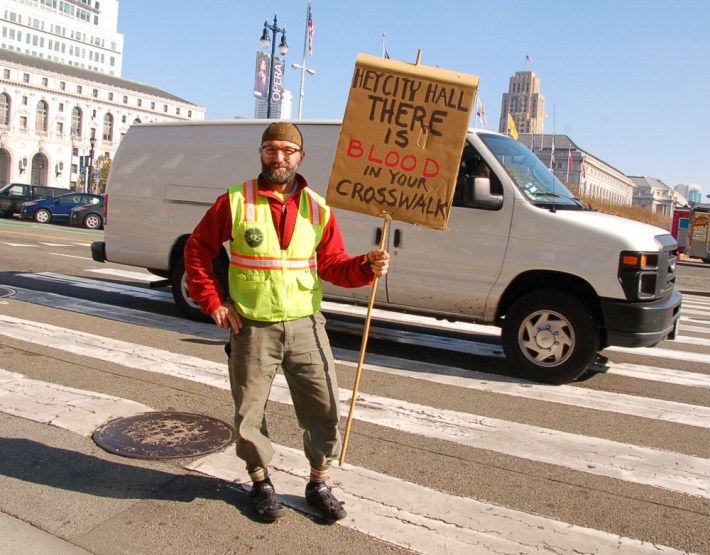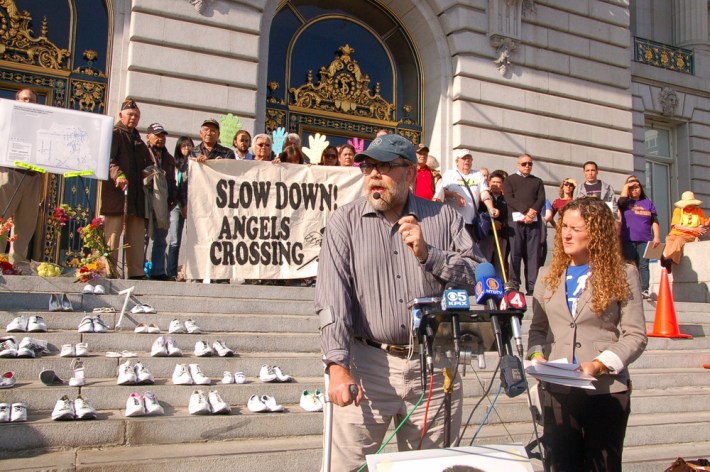
The recent spate of drivers killing or maiming pedestrians has both City Hall leaders and SF agencies running out of excuses for their snail's-pace implementation of measures that would make city streets safer.
At a rally on Friday, a coalition of safe streets advocates chanted, "Enough is enough." The 28 people killed in crashes on city streets this year, 18 of them pedestrians, puts SF on pace to surpass last year's number of fatalities.
At the event, 28 pairs of white shoes were placed on City Hall's steps to represent this year's deaths.
SF Bicycle Coalition Executive Director Leah Shahum pointed out that, with about three people hit by cars in SF every day, the shoes represent only a tiny fraction of injury victims whose lives are often ruined. "There are more than 100 times this many people injured," she said. "People with broken limbs, with irreversible trauma and damage to their bodies."
"For every person involved in gun violence in San Francisco, there are five people who are hit by cars," said Walk SF Executive Director Nicole Schneider. "We don't call this violence for some reason, but cars are also weapons. They take people's lives, they take people's limbs."
Those killed or seriously injured by drivers on SF's streets are disproportionately likely to be minorities, seniors, and people with disabilities. Over half of those killed this year were seniors -- including 68-year-old Priscila "Precy" Moreto, who was killed on October 23 in the crosswalk right in front of the City Hall steps where the rally was held. One man at the event, Miles Epstein, held a sign reading, "Hey City Hall, there is blood in your crosswalk."
Friday's rally was not just a call to action, but also a memorial for victims like Moreto, a Filipino-American woman who was run over by a tour trolley driver who was apparently distracted while narrating to passengers. Rudy Asercion, executive director of the National Federation of Filipino American Association of SF, called on the Board of Supervisors to push for legal changes to ban tour drivers from narrating at the same time.
The event was far from the first pedestrian safety rally in SF. Pi Ra of the Senior and Disability Action Network, who has been active in pedestrian safety advocacy since 2000, said pedestrian safety advocates "get a sugar high" every few years when calling for action. Each time, city leaders provide lip service, but lasting change never seems to result.
The typical excuse, Ra said, is that there's no funding for safer streets, despite the vast economic toll of traffic injuries -- $15 million per year just for medical treatment, according to a 2011 report from the SF Department of Public Health. Traffic injuries account for one-fourth of all traumatic injuries in the city.
"We need action. We don't need more town hall meetings. We don't need any more plans," said Ra. "What about the cost of our lives? What about the costs around our injuries? That's costing far more than the little bit of money we're asking for to make it safe for everybody."
"We have the funding, and we have the political will," said Shahum. "What's missing? It's the action."

Last week, SF voters approved Propositions A and B, two measures that will provide a significant increase in funding for Muni and street safety improvements. SFMTA spokesperson Paul Rose said the measures "will provide funds to make more street safety improvements -- such as transit signal upgrades, raised crosswalks, [and] pedestrian countdown signals -- that will help us achieve Vision Zero."
Voters' rejection of Proposition L, which called for putting cars first and attacked safer street designs, "could symbolize that people agree that the best tools we can deploy to improve traffic and safety conditions, and make parking more available, is to make public transit and our overall transportation system better," Rose said.
"We look forward to working with Mayor Lee and other elected leaders to ensure the funding measures help improve our transportation today, and for the future," he added.
Mayor Lee announced the city's five-year WalkFirst plan in March, but no near-term timeline has been announced beyond a list of 24 Vision Zero projects -- comprising mostly projects already in progress -- announced by the SFMTA in April.
At an event today, Mayor Lee made some more promises to take action. In an interview with KQED's Bryan Goebel (Streetsblog SF's founding editor), Lee said, “We’re going to be proceeding in a very aggressive way, completing all those 24 projects." Goebel reports:
“I’ll do my best to accelerate all these programs,” he said, adding that he’s been meeting with officials at the Department of Public Works and the Municipal Transportation Agency. “I’m basically going to break down any bureaucracies that hold us back on getting these projects done. ”
Lee also told Goebel that "if I hadn’t had a busy day that day, I would have probably joined them" at the rally. "I understand, and I agree we’re in a hurry... you’re going to see me out there with the advocates, with Walk SF, with the coalition, because I can’t stand for one more accident to occur."
It's worth pointing out that Mayor Lee still uses the term "accident," rather than "crash" or "collision," as used by SFPD and other city officials.
Walk SF and the Vision Zero coalition called for three specific steps for city leaders:
- Implement safety improvements along the most dangerous streets citywide, including reducing fast-moving traffic, eliminating high-injury corridors through the City’s WalkFirst strategy, and building physically protected bikeways.
- Establish a Crisis Intervention Team to investigate, and respond with on-street safety improvements within six months, to severe and fatal crashes in San Francisco.
- Increase enforcement and education measures for professional drivers operating in San Francisco’s complex urban environment.
Schneider also called on the SFPD to make its data on traffic crashes and enforcement more accessible. "Share data between departments. Don't just hold it at the SFPD, for us to go searching."
The most urgent action is needed in SoMa, which is criss-crossed with SF's deadliest high-speed traffic sewers. Angelica Cabande of the South of Market Community Action Network said that virtually no children in the neighborhood will say that they feel safe crossing the street. Instead, they'll tell stories of traffic violence and routine near-misses.
"We are the entrance and exit to five freeways," said Cabande. "While we appreciate the city responding to this cause, the response is not fast enough."
Pointing to the crosswalk where Moreto was killed, Shahum said, "It will be a tragedy if all the city does is put a light at this intersection."




